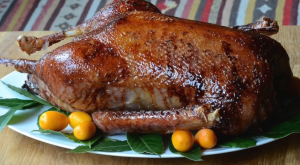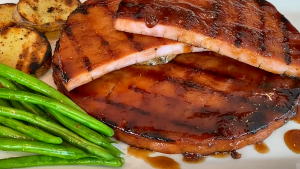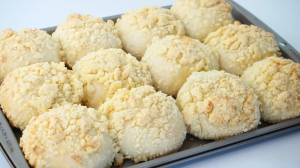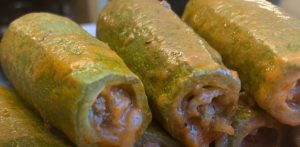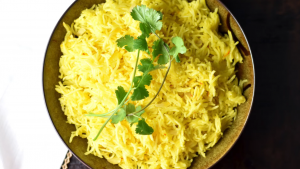Embark on a culinary journey with this classic roast goose with port gravy recipe. This dish, with its rich flavors and succulent meat, is often associated with festive occasions. The port gravy adds an interesting twist to the traditional roast, providing a rich and luscious accompaniment that beautifully complements the goose. This recipe is sure to impress your guests and provides an elegant centerpiece for any dining table.
A couple of ingredients in this recipe may not be commonly found in a home kitchen, such as the goose and tawny port wine. Goose is often available at butcher shops or high-end supermarkets, but you may need to order it in advance especially around the holidays. Tawny port wine, a type of Portuguese fortified wine, is available in liquor stores or the wine section of supermarkets. Its unique flavor greatly enhances the gravy.
Ingredients for Roast Goose with Port Gravy
Goose: The star of the dish, known for its rich and flavorful meat. Make sure to get a fresh one for the best results.
Onions: Adds sweetness and depth to the dish.
Celery: Used for stuffing, lending its unique flavor to the goose.
French bread: Used for stuffing to absorb all the lovely juices from the goose.
Carrots: Adds sweetness and color to the dish.
Boiling water: Used to pour over the goose for roasting.
Dry white wine: Used for deglazing the pan. Choose a good quality one for the best flavor.
Tawny port wine: Gives the gravy its unique and rich flavor.
All purpose flour: Used to thicken the gravy.
Chicken broth: Adds flavor and depth to the gravy. Homemade is the best, but store-bought works well too.
Salt and ground black pepper: Essential seasonings to bring out the flavors of the ingredients.
One reader, Celle Brumley says:





The roast goose with port gravy recipe was a game-changer for our holiday dinner. The goose was succulent, and the port gravy added a rich, flavorful touch. The recipe was easy to follow, and the end result was a showstopper. It's now a family favorite, and I can't wait to make it again!
Key Techniques for Making Roast Goose with Port Gravy
How to roast the goose: The process of roasting the goose involves seasoning, stuffing, and cooking it to perfection. This requires knowledge of proper temperature and timing to ensure the goose is cooked through while maintaining its juiciness.
How to make port gravy: This involves deglazing the roasting pan, creating a roux, and then combining it with the deglazed liquid to make a flavorful gravy. It's important to know how to adjust the consistency and season the gravy to taste.
How To Make Roast Goose with Port Gravy
Stuffed with French bread and celery, this roast goose recipe makes the most out of each part. Goose fat is mixed with port wine for tastier port gravy.
Serves:
Ingredients
- 1fresh goose,(12 oz)
- 3onions
- 2stalkscelery
- 4slicesfrench bread
- 2carrots
- 1cupboiling water
- 1cupdry white wine
- ¼cuptawny port wine
- ⅓cupall purpose flour
- 3cupschicken broth
- salt and ground black pepper,to taste
Instructions
-
Discard loose fat from goose. Remove neck, cut into large pieces, and reserve. Rinse goose inside and out, and pat dry. Pierce skin of goose all over, and season with salt and pepper.
-
Loosely pack neck cavity with enough bread to fill out the cavity. Fold neck skin under body, and fasten with a small skewer. Quarter 1 onion and all the celery, and place inside the body cavity of the goose.
-
Tie legs together loosely with kitchen string, or insert legs through a slit in the lower skin flap. Transfer goose, breast side up, to a rack set in a deep roasting pan.
-
Cut remaining onions and carrots into 2-inch pieces. Scatter onion and carrot pieces, neckpieces, and giblets in a roasting pan. Roast goose at 425 degrees F in the middle of the oven for 30 minutes.
-
Reduce temperature to 325 degrees F. Carefully pour boiling water over goose; juices may splatter. Continue roasting goose, skimming off fat, and basting with pan juices using a metal bulb baster every 20 minutes.
-
Cook for 2 to 2½ hours more, or until a meat thermometer inserted in the fleshy part of the thigh registers 175 degrees F. When done, the juices should run clear when the thigh is pierced with a skewer.
-
Transfer goose to a heated platter. Remove skewer and discard string. Keep goose warm, loosely covered with foil, until ready to serve.
-
With a slotted spoon discard vegetables, neck pieces, and giblets from pan. Spoon off fat from pan juices, and reserve. On top of stove, deglaze pan with white wine and port over moderately high heat; scrape up brown bits.
-
Add chicken broth, and boil mixture until reduced by about half. In a 12-cup heavy saucepan, whisk together ¼ cup reserved fat and flour; cook roux over moderately low heat, whisking to prevent lumps.
-
Whisk chicken broth mixture into the roux. Bring gravy to a boil, whisking constantly. Turn down heat. Simmer gravy, whisking frequently, for 5 minutes or until thickened.
-
Season gravy with salt and pepper. Transfer gravy to a heated sauceboat.
-
Serve and enjoy.
Nutrition
- Calories: 1078.75kcal
- Fat: 89.82g
- Saturated Fat: 26.10g
- Trans Fat: 0.00g
- Monounsaturated Fat: 47.33g
- Polyunsaturated Fat: 10.16g
- Carbohydrates: 14.54g
- Fiber: 1.65g
- Sugar: 4.04g
- Protein: 45.26g
- Cholesterol: 213.20mg
- Sodium: 1053.01mg
- Calcium: 61.85mg
- Potassium: 1049.05mg
- Iron: 7.43mg
- Vitamin A: 149.56µg
- Vitamin C: 14.97mg
Expert Tip for Perfecting the Port Gravy
When roasting a goose, it's important to frequently baste it with its own juices. This not only keeps the bird moist, but also adds flavor and helps to achieve a beautifully browned and crispy skin. However, be careful when pouring boiling water over the goose as the juices may splatter. Using a metal bulb baster can make this process easier and safer. Also, remember to skim off the excess fat during the roasting process. This fat can be reserved and used to make a delicious roux for your port gravy.
Time-Saving Tips for Preparing Roast Goose
Prepare the ingredients: Gather and prepare all the ingredients and equipment needed before starting the recipe to streamline the cooking process.
Use a meat thermometer: Use a meat thermometer to accurately gauge the doneness of the goose, ensuring it is perfectly cooked without overdoing it.
Baste efficiently: Use a large baster to efficiently baste the goose, reducing the frequency of opening the oven and saving time during the cooking process.
Multi-task: While the goose is roasting, use the time to prepare the port gravy and other side dishes to maximize efficiency in the kitchen.
Plan ahead: Plan the cooking schedule in advance, allowing for ample time to prepare and cook the roast goose while managing other tasks in the kitchen simultaneously.
Streamline the process: Organize the cooking area and streamline the process by arranging ingredients and tools in an efficient manner, reducing the time spent searching for items during cooking.
Prep the vegetables: Pre-cut and prepare the vegetables in advance, ensuring they are ready to be used when required in the recipe, saving time during the cooking process.
Utilize kitchen gadgets: Use kitchen gadgets such as a food processor or mandoline to quickly and efficiently prepare ingredients, reducing manual prep time.
Opt for pre-made components: Consider using pre-made components such as store-bought chicken broth or pre-cut vegetables to save time during the preparation process.
Efficient clean-up: Clean as you go to maintain an organized cooking space, reducing the time spent on post-cooking clean-up and allowing for a more efficient cooking process.
Substitute Ingredients For Roast Goose with Port Gravy Recipe
goose - Substitute with duck: Duck is a suitable substitute for goose, as it has a similar rich and flavorful taste, and can be prepared in a similar manner.
French bread - Substitute with baguette: A baguette can be used as a substitute for French bread, as it has a similar texture and flavor, and will work well for soaking up the delicious gravy.
Presentation Ideas for a Stunning Roast Goose Dish
Elevate the plating: Arrange the roast goose slices in an artful manner on the plate, ensuring that each slice is presented elegantly and invitingly.
Garnish with fresh herbs: Sprinkle the dish with a delicate arrangement of fresh herbs such as thyme, rosemary, or parsley to add a pop of color and a touch of freshness to the presentation.
Drizzle with port gravy: Artfully drizzle the rich and flavorful port gravy around the goose slices, ensuring that each portion is adorned with a generous amount of the savory sauce.
Add a touch of elegance with edible flowers: Carefully place a few edible flowers around the plate to add a touch of sophistication and a visually stunning element to the presentation.
Incorporate seasonal elements: Consider incorporating seasonal elements such as decorative gourds, miniature pumpkins, or autumn leaves to create a visually captivating and seasonally appropriate presentation.
Use elegant serving ware: Select elegant and sophisticated serving ware that complements the dish, such as fine china or artisanal ceramic plates, to enhance the overall presentation.
Create height and dimension: Consider building height and dimension on the plate by layering the goose slices and garnishes, creating a visually striking and dynamic presentation.
Pay attention to negative space: Utilize negative space on the plate to create a balanced and visually appealing presentation, allowing the dish to stand out as the focal point.
Highlight the goose's golden brown skin: Ensure that the golden brown, crispy skin of the roast goose is prominently displayed, adding a visually appealing and appetizing element to the presentation.
Finish with a dusting of seasoning: Lightly dust the plate with a sprinkle of freshly ground black pepper or a touch of fleur de sel to add a final touch of flavor and visual interest to the presentation.
Essential Kitchen Tools for Preparing Roast Goose
- Oven: An essential appliance for roasting the goose to perfection, providing even heat distribution for a crispy and succulent finish.
- Roasting pan: This is used to hold the goose and catch any drippings during the roasting process, ensuring the meat cooks evenly and stays moist.
- Meat thermometer: A crucial tool for checking the internal temperature of the goose to ensure it is cooked to the desired level of doneness.
- Metal bulb baster: Used for basting the goose with its own juices, adding flavor and moisture to the meat as it cooks.
- Slotted spoon: This tool is used to remove the vegetables, neck pieces, and giblets from the roasting pan, leaving behind the flavorful pan juices.
- Saucepan: Essential for deglazing the roasting pan and preparing the port gravy, allowing for even heating and easy stirring.
- Whisk: Used for making the roux and whisking the chicken broth mixture to create a smooth and flavorful gravy.
- Kitchen string: Essential for tying the goose's legs together, ensuring even cooking and a beautiful presentation when serving.
- Platter: A large serving dish used for presenting the roasted goose, allowing for an elegant and appetizing display.
- Foil: Used to loosely cover the roasted goose, keeping it warm and allowing the juices to redistribute before serving.
Storage and Freezing Guidelines for Roast Goose
Let the roast goose cool completely before storing or freezing. This will prevent condensation from forming and affecting the quality of the meat.
Wrap the cooled goose tightly in plastic wrap or aluminum foil, making sure to remove as much air as possible. This will help prevent freezer burn and maintain the quality of the meat.
If you plan to store the goose in the refrigerator, place it in an airtight container or resealable plastic bag. It will keep for up to 4 days in the refrigerator.
To freeze the goose, place the wrapped meat in a freezer-safe container or resealable plastic bag. Label the container or bag with the date and contents, so you can easily keep track of when it was frozen.
The roast goose can be stored in the freezer for up to 6 months. When you're ready to enjoy it again, thaw the meat in the refrigerator overnight before reheating.
To store the port gravy, let it cool completely before transferring it to an airtight container. It will keep in the refrigerator for up to 4 days.
If you want to freeze the gravy, pour it into a freezer-safe container or resealable plastic bag, leaving some room at the top for expansion. Label the container or bag with the date and contents.
The port gravy can be stored in the freezer for up to 3 months. To reheat, thaw the gravy in the refrigerator overnight and then warm it gently in a saucepan over low heat, stirring occasionally.
How To Reheat Leftover Roast Goose and Port Gravy
Preheat your oven to 350°F (175°C). Place the leftover roast goose in an oven-safe dish and cover it with aluminum foil. Reheat the goose in the oven for about 20-25 minutes, or until it reaches an internal temperature of 165°F (74°C). This method helps to retain the moisture and prevent the meat from drying out.
For a quicker option, you can use a microwave. Place the goose pieces in a microwave-safe dish and cover them with a damp paper towel. Microwave on high for 1-2 minutes, or until the meat is heated through. Be careful not to overheat, as this can cause the meat to become tough and rubbery.
If you have a lot of leftover goose, consider slicing it and reheating it in a skillet over medium heat. Add a small amount of butter or oil to the pan to prevent sticking and to add some extra flavor. Cook the slices for 2-3 minutes on each side, or until they are heated through and slightly crispy.
For the port gravy, reheat it in a saucepan over low heat, stirring occasionally. If the gravy has thickened too much, you can thin it out by adding a small amount of chicken broth or water. Be sure to taste the gravy and adjust the seasoning as needed.
If you want to get creative with your leftovers, consider using the roast goose in a sandwich or wrap. Slice the goose thinly and pair it with your favorite toppings, such as cranberry sauce, arugula, and brie cheese. The combination of flavors and textures will give your leftovers a new lease on life.
Interesting Trivia About Roast Goose and Port Gravy
The roast goose with port gravy recipe is a traditional dish often enjoyed during festive occasions such as Christmas or Thanksgiving. It is a popular choice for holiday feasts due to its rich and flavorful taste. The process of roasting the goose helps render the fat, resulting in crispy skin and succulent meat. The addition of port wine to the gravy adds a depth of flavor and richness to the dish, making it a standout centerpiece for any celebratory meal. This dish has been enjoyed for generations and continues to be a beloved choice for special gatherings and feasts.
Is Making Roast Goose at Home Cost-Effective?
The cost-effectiveness of this roast goose with port gravy recipe largely depends on the availability and cost of the ingredients. While goose and port wine can be on the pricier side, the dish can be a luxurious and impressive option for special occasions. The approximate cost for a household of 4 people would be around $60-$80. The rich flavors and elegant presentation make it a standout choice for a special dinner, earning it a solid 8/10 rating for its taste and appeal.
Is Roast Goose with Port Gravy Healthy or Unhealthy?
This roast goose with port gravy recipe is relatively unhealthy due to several factors:
- Goose is a fatty meat, and the recipe calls for roasting it at a high temperature, which can lead to the formation of harmful compounds like heterocyclic amines (HCAs) and polycyclic aromatic hydrocarbons (PAHs).
- The gravy is made with a roux (a mixture of fat and flour), which adds extra calories and saturated fat to the dish.
- The recipe uses white wine and port, which contribute to the overall calorie count and provide little nutritional value.
However, there are some positive aspects, such as the inclusion of vegetables like onions, celery, and carrots, which provide some essential nutrients.
To make this recipe healthier, consider the following suggestions:
- Trim excess fat from the goose before roasting to reduce the overall fat content.
- Use a lower temperature and longer cooking time to minimize the formation of harmful compounds.
- Replace some of the goose fat in the gravy with a healthier alternative, such as olive oil or vegetable broth.
- Increase the amount of vegetables in the dish to boost the nutrient content and provide more fiber.
- Serve the goose with a side of steamed or roasted vegetables to balance out the meal and add more vitamins and minerals.
- Use whole wheat flour instead of all-purpose flour in the gravy to increase the fiber content.
- Reduce the amount of wine and port used in the recipe, or substitute them with low-sodium chicken broth to lower the calorie and alcohol content.
Editor's Opinion on the Roast Goose with Port Gravy Recipe
The roast goose with port gravy recipe is a classic and elegant dish that showcases the rich flavors of the goose and the depth of the port gravy. The method of roasting the goose ensures a crispy skin and tender, succulent meat, while the port gravy adds a luxurious touch with its rich, savory flavor. The combination of aromatics and wine in the roasting process infuses the goose with layers of delicious taste. This recipe is perfect for a special occasion or holiday feast, and it will surely impress your guests with its indulgent and sophisticated appeal.
Enhance Your Roast Goose with Port Gravy Recipe with These Unique Side Dishes:
Similar Recipes to Try If You Enjoy Roast Goose
Appetizer and Dessert Pairings for Roast Goose with Port Gravy
Why trust this Roast Goose with Port Gravy Recipe:
This roast goose with port gravy recipe is a timeless classic that has been passed down through generations. The combination of goose and port wine creates a rich and flavorful dish that is perfect for special occasions. The step-by-step instructions ensure that even novice cooks can successfully prepare this impressive meal. The use of fresh ingredients and traditional cooking methods guarantees an authentic and delicious dining experience. Trust in the expertise and attention to detail that goes into crafting this exceptional recipe.
Was this page helpful?
Have your own special recipe to share? Submit Your Recipe Today!



